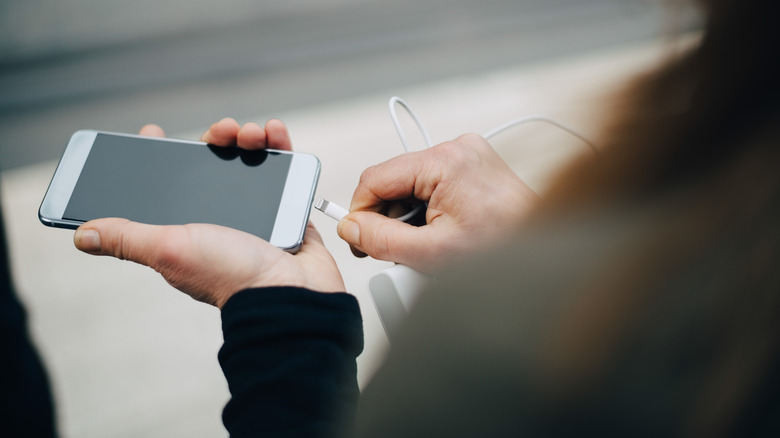Here's How To Make Your Phone Battery Last Longer While Traveling
This is it: the moment you've been waiting for your entire trip. You've finally reached that stunning viewpoint after hiking for hours — or you're standing in front of an iconic landmark you've dreamed of visiting — and you slowly pull your phone out of your pocket ... only for it to die just as you're about to capture the moment. Talk about a travel nightmare, right?
Nowadays, it's safe to say that we rely on our phones a lot — especially if we're traveling and need to navigate unfamiliar streets, translate menus, or even book last-minute tickets. That said, a dead phone battery can transform even the most exciting getaway into a stressful situation that leaves you frustrated and, worse, totally disconnected.
Thankfully, there's an easy and practical way to avoid the situation entirely: managing your phone's battery life. A vital, not-so-talked-about travel skill — one that's up there with mastering the top tips for successfully packing light and knowing the secret to finding the best restaurants when visiting a new city — understanding your phone's power needs can change the travel game. From smart charging habits to temperature management, simple changes in how you use your device can make a big difference. Because whether you're planning a weekend getaway or embarking on a month-long journey, extending your phone's battery life can make a massive difference.
Smart charging habits help protect your phone's battery
Contrary to popular belief, keeping your phone charged to 100% isn't doing your battery any favors. According to experts, while most modern phones are designed to prevent overcharging, maintaining a constant full charge still creates unnecessary strain on the battery. With that in mind, you should strive to keep your phone between 20% and 80% — a sweet spot that'll help preserve your battery's long-term health. Plus, this approach will also work better with modern travel habits too, since you can adopt more sustainable charging patterns — like taking advantage of short charging breaks during coffee stops or airport layovers — rather than relying on overnight charging sessions.
At the same time, there's also the matter of how you charge your phone. Because while seemingly harmless things like wireless chargers and battery cases might seem convenient, they can actually generate excess (and unnecessary) heat that'll damage your battery over time. Instead, consider using a high-quality portable power bank for on-the-go charging that won't overheat your device while preventing long-term battery degradation at the same time. This Anker Portable Charger, for example, is a great option that holds up to 3.6 charges (depending on your phone brand and model) and is light enough to carry around.
Speaking of chargers, having the right type of phone charger if you're traveling abroad also requires careful consideration — especially when dealing with different voltage systems and plug shapes and sizes. As for third-party cables — just don't do it. While they might save you some cash at first, they often lack the protective features that prevent overcharging — which ultimately shortens your battery's lifespan and could potentially damage your device.
Other daily habits that might impact battery life
Beyond charging practices, there are plenty of other external factors that can affect your phone's battery. For starters, weather and temperature play a big role. After all, your phone (and its battery) are both surprisingly sensitive to environmental conditions that are either too hot or too cold. This means that extreme weather situations — like exposure to direct sunlight while sunbathing on a beach in Spain or sub-zero temperatures while exploring the coldest cities in the world — can force your battery to work overtime and, as a result, drain it a lot faster. Instead, you're going to want to keep your phone at a comfortable temperature — somewhere between 62 and 72 degrees Fahrenheit for an Apple phone and 32 to 95 degrees Fahrenheit for a Samsung device — in order to maintain optimal battery performance.
From there, other daily habits and settings that can help you maximize battery life include things like adjusting your screen brightness, limiting push notifications (these tend to constantly wake up your phone and run background processes that drain power), and close any apps that you're not currently using. In addition to this, turn on battery saving settings or low power mode when you aren't actively using your phone. Not only will these quick tips make your phone battery last a lot longer, but they'll also help protect your battery's long-term health — and trust us, your future self will thank you when you're still able to snap photos at the end of a long day of exploring.


